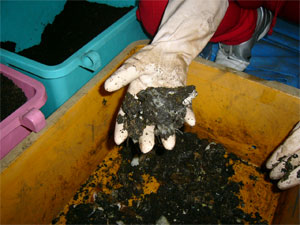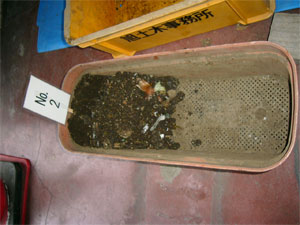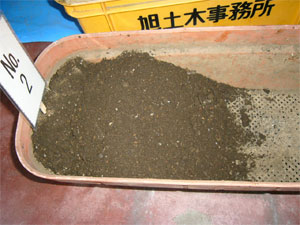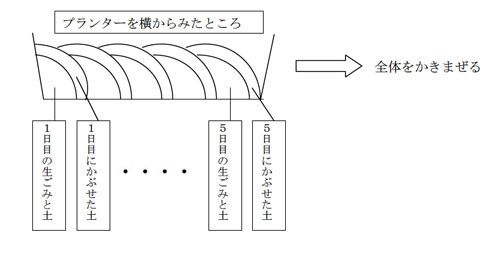- Yokohama-shi Top Page
- Asahi Ward Top Page
- Lifestyle and procedures
- Housing and Living
- Waste and Recycling
- kitchen garbage easily recycled soil mixing method
Here's the text.
kitchen garbage easily recycled soil mixing method
Last update date November 12, 2018
What is Soil Mixing Method?
This is a method of mixing kitchen garbage with soil, decomposing kitchen garbage with the power of microorganisms in the soil and turning the soil into nutrients.
Benefits
- Don't take a place.
Even if you don't have a garden, you can do it as long as you have space for 4 planters. - Anyone can do it in a simple way.
No special work or tools or chemicals are required. - The resulting soil can be used for gardening.
- You don't have to worry about the use of the soil.
The resulting soil can be used for soil mixed with kitchen garbage again, so there is no need to worry about increasing soil. - Eco-friendly.
You can easily recycle kitchen garbage at home without disposing of it as garbage.
What to prepare
- kitchen garbage
- SAT
- Plantter
Procedure
The soil mixing method decomposes kitchen garbage with the power of microorganisms, so it is important to create an environment where microorganisms can work easily. Specifically, work will be carried out while paying attention to the adjustment of moisture content and oxygen supply.
1.Mix the small chopped kitchen garbage and the soil.
The smaller the kitchen garbage, the quicker it is. (Approximately 2 to 3 cm)

Photo: Mixture of kitchen garbage and soil
The moisture enough to make soil steamed buns to the extent that it feels moist.
Points: Adjusting water content
2.Put a mixture of kitchen garbage and soil into one of the planters.

3.Cover the soil from above so that kitchen garbage hides.
It shuts out insects and smells by applying soil well so that kitchen garbage cannot be seen.

4.When the planters are full, stir the whole thing.

- After that, stir occasionally (approximately once a week) is quicker to disassemble.
Points: Supply of oxygen - If it is too dry when stirring, add water. If there is a lot of moisture, add dry soil and mix.
Points: Adjusting water content
5.Continue in the same way with other planters.
When the four planters are full, the first planter is completed.
FAQs
Q1: Is there any kitchen garbage that does not suit the soil mixing method?
A1: Large amounts of waste cooking oil (slightly acceptable), shellfish and onion skin
Q2: What kind of soil should I start with?
A2: Any soil that you no longer need after planting flowers.
Q3: Where do you put the planters?
A3: It is important to maintain 50% moisture, so place it in a place where it is not exposed to direct sunlight and does not rain (such as under the eaves).
Q4: The inside of the planters that are being disassembled is japonic.
A4: Put the dry soil or take it out of the planter and apply it to sunlight and return it to 50% moisture.
Q5: The soil and kitchen garbage are dry and their shape remains forever.
A5: I'm running out of water. Add water, stir and bring it back to 50% of water.
Q6: I'm worried about flies, buds and smells.
A6: You don't have to worry about covering the kitchen garbage.
Q7: How long will it be done?
A7: Summer is from 1 week to 10 days and winter is 3 to 4 weeks.
Q8: Isn't there a problem because the soil increases?
A8: In addition to growing plants, the resulting soil can be circulated and used as the first mixed soil, so there is no problem with increasing soil.
Soil analysis
After putting kitchen garbage into commercially available black soil for 30 days, we asked a specialized agency to analyze it. As a result, the resulting soil was found to be good soil for growing flowers and vegetables. For more information, please contact Regional Promotion Division Resources Reuse Promotion. (conducted in December 2009)
Seminar
We hold seminars at Regional Promotion Division Resources Reuse Promotion. Please feel free to contact us for more information.
For inquiries to this page
Asahi Ward General Affairs Department Regional Promotion Division
Phone: 045-954-6095
Phone: 045-954-6095
Fax: 045-955-3341
Email address: as-chishin@city.yokohama.jp
Page ID: 318-030-170












